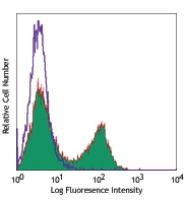-
Sign In
-

-
 Sony Biotechnology
Sony Biotechnology
-

-
 Sony Biotechnology
Sony Biotechnology
Pacific Blue™ anti-mouse CD3
Antibodies Single
Sony
17A2
Flow Cytometry
Rat IgG2b, κ
Mouse
γδTCR-positive T-T hybridoma D1
1101065
$98.00
Description
CD3, also known as T3, is a member of the Ig superfamily and primarily expressed on T cells, NK-T cells, and at different levels on thymocytes during T cell differentiation. CD3 is composed of CD3ε, δ, γ and ζ chains. It forms a TCR complex by associating with TCR α/β or γ/δ chains. CD3 plays a critical role in TCR signal transduction, T cell activation, and antigen recognition by binding the peptide/MHC antigen complex.
Formulation
Phosphate-buffered solution, pH 7.2, containing 0.09% sodium azide.Recommended Usage
Each lot of this antibody is quality control tested by immunofluorescent staining with flow cytometric analysis. For flow cytometric staining, the suggested use of this reagent is ≤1.0 microg per 106 cells in 100 microL volume. It is recommended that the reagent be titrated for optimal performance for each application.
* Pacific Blue™ has a maximum emission of 455 nm when it is excited at 405 nm. Prior to using Pacific Blue™ conjugate for flow cytometric analysis, please verify your flow cytometer's capability of exciting and detecting the fluorochrome.
References
1. Miescher GC, et al. 1989. Immunol. Lett. 23:113. (IP, IHC, Activ, CMCD)
2. Mysliwietz J, et al. 1992. Blood 80:2661. (Deplete)
3. Wu L, et al. 1991. J. Exp. Med. 174:1617. (CMCD)
4. Zhang Y, et al. 2002. J. Immunol. 168:3088. (IHC)
5. Zan H, et al. 2005. EMBO J. 24:3757.
6. Morgado P, et al. 2011. Infect Immun. 79:4401. PubMed
7. Xiao J, et al. 2012. Arterioscler Thromb Vasc Biol. 32:386. PubMed
8. Benndorfer ED, et al. 2014. J Immunol. 192:1671. PubMed
9. O E, et al. 2014. J Virol. 88:7764. PubMed
10. Shimoi A, et al. 2014. J Immunol. 193:849. PubMed
11. Nagaoka M, et al. 2014. J Immunol. 193:2812. PubMed
12. Christian DA, et al. 2014. Infect Imun. 82:4056. PubMed


